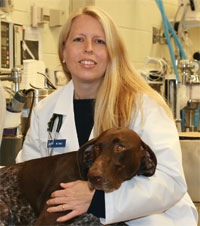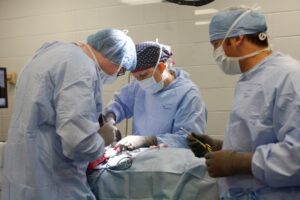-
Adopt
-
Veterinary Care
Services
Client Information
- What to Expect – Angell Boston
- Client Rights and Responsibilities
- Payments / Financial Assistance
- Pharmacy
- Client Policies
- Our Doctors
- Grief Support / Counseling
- Directions and Parking
- Helpful “How-to” Pet Care
Online Payments
Referrals
- Referral Forms/Contact
- Direct Connect
- Referring Veterinarian Portal
- Clinical Articles
- Partners in Care Newsletter
CE, Internships & Alumni Info
CE Seminar Schedule
Emergency: Boston
Emergency: Waltham
Poison Control Hotline
-
Programs & Resources
- Careers
-
Donate Now
 by Sue Casale, DVM, DACVS
by Sue Casale, DVM, DACVS
angell.org/surgery
617-541-5048
surgery@angell.org
Surgical site infections (SSI) are the most frequent type of nosocomial infections seen in both human and veterinary hospitals.1 SSI significantly increases the cost of health care by increasing the length of hospital stay, delaying wound healing and increasing the use of antibiotics.1 In addition, there is an increase in patient morbidity and possibly mortality. The most recent rate of SSI in human hospitals has been reported as 1.9%.2 Higher SSI rates have been reported in dogs and cats with a 3% rate of “infection” and 5.8% “inflammation/infection” reported in one study.3 Many risk factors for SSI exist including, type of procedure, length of anesthesia, number of persons in the operating room, duration of hospital stay, patient immune system status, body weight and administration of antimicrobials.3,4 Although SSI cannot be completely eliminated, surveillance is important to help institute procedures and policies to eliminate any infection that can be reasonably prevented. Adapting policies to account for changes in evidence based research is essential.
Surgical hand antisepsis is an important part of preparation for surgery. The purpose of surgical preparation is to protect the patient in the case of glove perforation. Glove perforation has been reported in 23.3 – 26.2% of veterinary surgeries with the surgeon unaware of the perforation in most cases.5,6 Risk for glove perforation is higher in procedures lasting more than one hour and orthopedic procedures.6 The non-dominant hand has a higher risk of glove perforation.5 Because of the high rate of glove perforation, surgical hand antisepsis is essential to reduce resident skin flora and eliminate transient microbes.
Traditional surgical scrub consists of a timed anatomic scrub with a brush and antiseptic soaps containing chlorhexidine or povidone iodine. A nail pick is used as the highest bacterial counts are found under the nails. All surfaces of the hands and arms are scrubbed for five minutes and then rinsed with tap water and dried with a sterile towel. Over the past decade, the use of the traditional surgical scrub has been questioned. Surgical scrub brushes with firm bristles cause small excoriations in the skin and are no longer recommended.7 Repeated hand washings damage the barrier function of the stratum corneum and skin becomes more permeable to toxins and microorganism.8 The products used for scrubbing alter the lipid layer of the skin causing a loss of natural antimicrobial factors. As a result, the hands of surgical staff tend to have higher bacterial contamination of the skin and the organisms that are present tend to be more pathogenic.9
Alcohol based hand rubs (AHR) are an alternative to the traditional scrub that is gaining popularity among surgeons in human hospitals. Alcohol-based hand rubs have been advocated to replace the traditional scrub because of several distinct advantages. There is increasing evidence that alcohol rubs are as effective if not more effective than the traditional scrub.10,11,12, 13 The main ingredient in AHR is ethanol, isopropanol or n-propanol although some also contain additional antiseptics such as chlorhexidine. Alcohol has rapid and immediate antibacterial action, and the sustained effect of AHR has been shown to be better than chlorhexidine.12 Rubs are faster to use than the traditional aqueous scrub and causes less skin damage with repeated use. Alcohol allergy is extremely rare and resistance or toxic effects have not been reported.13,14 The cost savings of AHR over aqueous scrub is as high as 67%.12 Other advantages include less environmental impact as neither a scrub brush nor water is used. Traditional surgical scrub can use up to 20 liters of water.15 Currently the World Health Organization (WHO) lists AHR as the recommended method of hand asepsis.16 Application of AHR must strictly follow manufacturer’s instructions as SSI clusters have been reported after improper technique was used.17 Hand washing prior to application is unnecessary unless hands are visibly soiled. Omitting hand washing increases the efficacy of AHRs.18 A nail pick should be used and the time of application varies based on manufacturer instructions, but is often less than two minutes.
Despite these advantages, surgical rubs have been slow to catch on in the veterinary community.14 A recent survey of hand preparations methods showed only 20% of veterinary surgeons use rubs as the primary method of hand antisepsis.14 AHR have been used successfully at Angell Animal Medical Center since 2007. Although the traditional scrub has not been eliminated and is often performed as the first scrub of the day or if hands are visibly soiled, improved skin tolerance, ease of use and time savings has resulted in AHR being the preferred method for hand antisepsis at Angell.
For more information about Angell’s Surgery service, please visit www.angell.org/surgery. Dr. Casale can be reached at 617-541-5048, or by e-mailing scasale@angell.org or surgery@angell.org.
References:
- Nelson, L. Surgical site infections in small animal surgery. Vet Clin Small Anim 2011; 4:1041-1056.
- Mu, Y., et al., Improving risk-adjusted measures of surgical site infection for the national healthcare safety network. Infect Control Hosp Epidemiol, 2011; 32(10):970-86.
- Eugster, S, Schawalder, P, et al. A prospective study of postoperative surgical site infections in dogs and cats. Vet Surg 2004; 33:542-550.
- Frey, T, Heolzer, M, et al. Risk factors for surgical site infection-inflammation in dogs undergoing surgery for rupture of the cranial cruciate ligament: 902 cases (2005-2006). JAVMA 2010; 236(1):88-94.
- Character, B, McLaughlin, R, Hedlund, C et al. Postoperative integrity of veterinary surgical gloves. JAAHA 2003; 39:311-320.
- Hayes, G, Reynolds, D, Moens, N, et al. Investigation of incidence and risk factors for surgical glove perforation in small animal surgery. Vet Surg 2014; 43:400-404.
- Widmer, A, Rotter, M, Voss, A et al. Surgical hand preparation: state-of-the-art. J Hosp Infect 2010;74(2):112-122.
- Larson, E, Hughes, C, et al. Changes in bacterial flora associated with skin damage on hands of health care personnel. Am J Infect Control 198; 26:513-521.
- Coelho, J, Lerner, H et al. The influence of the surgical scrub on hand bacterial flora. Int Surg 1984; 69:305-307.
- Parienti, J, Thibon, P et al. Hand-rubbing with an aqueous alcoholic solution vs traditional surgical hand-scrubbing and 30-day surgical site infection rates. JAMA 2002; 288(6):722-727.
- Lai, K, Foo, T et al. Surgical hand antisepsis – a pilot study comparing povidone iodine hand scrub and alcohol-based chlorhexidine gluconate hand rub. Ann Acad Med Sinagapore 2012; 41:12-16.
- Tavolacci, M, Pitrou, I, et al. Surgical hand rubbing compared with surgical hand scrubbing: comparison of efficacy and costs. J Hosp Infect 2006; 63:55-59.
- Kampf, G, and Kramer, A. Epidemiologic backgrouns of hand hygiene and evaluation of most important agents for scrubs and rubs. Clin Microb Rev 2004; 863-893.
- Verwilghen, D, Grulke, S et al Presurgical hand antisepsis: concepts and current habits of veterinary surgeons. Vet Surg 2011; 40: 515-521.
- Jehle, K, Jarrett, N, Matthews, S: Clean and green: saving water in the operating theatre. Ann R Coll Surg Engl 2008; 90:22-24.
- World Health Organization (WHO) WHO Guidelines on Hand Hygiene in Health Care. Geneva Switzerland, WHO, 2009, 270pp.
- Haessler, S, Connelly, N, et al. A surgical site infection cluster: the process and outcome of an investigation – the impact of an alcohol-based surgical antisepsis product and human behavior. Anesth Analg 2010; 110: 1044-1048.
- Hubner, N, Kampf, G, Kamp, P et al. Does a preceding hand wash and drying time after surgical hand disinfection influence the efficacy of a propanol-based hand rub? BMC Microbiol 2006; 6:57-60.
